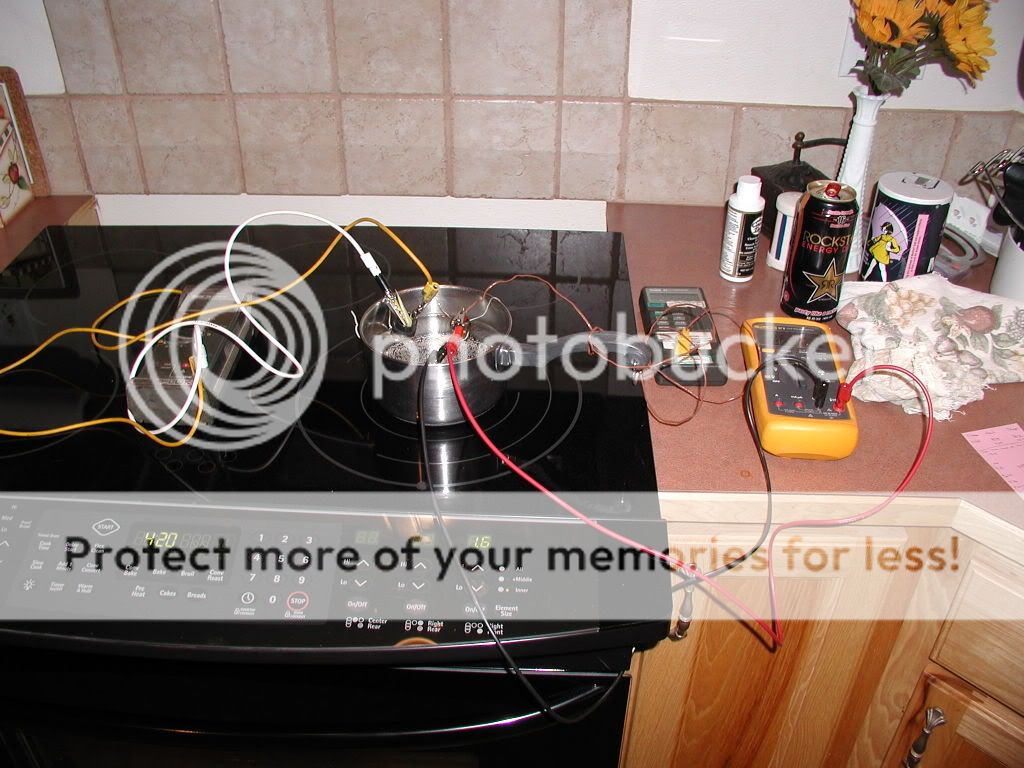Temperature reality time. I decided to buy a 16 inch fan from JEGS and while waiting for it, took out the old radiator and the fan temp switch and the temp sender unit.
I decided to break in my wife's brand new range just delivered on the 22nd, and set up a small pan of water with the sender unit and a type K thermocouple suspended in the water. I hooked the temp sender to a Fluke multimeter and the thermocouple to a Fluke thermocouple meter. I also suspended the fan switch and hooked it to a separate Fluke multimeter.
I took temp readings at each 5 ohms of resistance change. I will publish them all in a chart format soon. For now I found that 160 degrees is = to 145 ohms, 180 degrees is = to 105 ohms and 200 degrees is = to 75 ohms.
The fan switch closed at 177 degrees.
I then connected a variable 1K resistor to the lead from the car temperature meter and ground and adjusted it to have the car meter needle read on the 1st, 2nd and 3rd marks.
The first needle mark took 107 ohms, the 2nd or middle mark took 70 ohms and the 3rd or 3/4 mark took 45.9 ohms.
I connected a battery charger at a 2 amp charge to keep the battery voltage more or less stable at 13 volts.
With my sender unit this would appear to make the first mark = to a temperature of approximately 178 degree, the 2nd or middle mark = to 202 degrees and the 3rd or 3/4 mark = to somewhere in excess of 210 degrees. My highest water temp was 219 degrees with a resistance of 56.5 ohms.
This would seem to indicate when I have been driving my car at freeway speeds or around town without many stops the car has been at a temperature of around 202 degrees and in stop and go traffic when stopped it is going up to over 218 degrees. This is with a 180 degree thermostat.
Does this seem right? I worry now that it is on the hot side!
Where do most of your cars indicate on the temperature gauge at constantly moving speeds, 1st or 2nd mark? What is the highest you see them go when stopped on average? This top one can really be affected by the daily temp, but using 70 to 80 as normal daily range what do they seem to indicate?
I decided to break in my wife's brand new range just delivered on the 22nd, and set up a small pan of water with the sender unit and a type K thermocouple suspended in the water. I hooked the temp sender to a Fluke multimeter and the thermocouple to a Fluke thermocouple meter. I also suspended the fan switch and hooked it to a separate Fluke multimeter.
I took temp readings at each 5 ohms of resistance change. I will publish them all in a chart format soon. For now I found that 160 degrees is = to 145 ohms, 180 degrees is = to 105 ohms and 200 degrees is = to 75 ohms.
The fan switch closed at 177 degrees.
I then connected a variable 1K resistor to the lead from the car temperature meter and ground and adjusted it to have the car meter needle read on the 1st, 2nd and 3rd marks.
The first needle mark took 107 ohms, the 2nd or middle mark took 70 ohms and the 3rd or 3/4 mark took 45.9 ohms.
I connected a battery charger at a 2 amp charge to keep the battery voltage more or less stable at 13 volts.
With my sender unit this would appear to make the first mark = to a temperature of approximately 178 degree, the 2nd or middle mark = to 202 degrees and the 3rd or 3/4 mark = to somewhere in excess of 210 degrees. My highest water temp was 219 degrees with a resistance of 56.5 ohms.
This would seem to indicate when I have been driving my car at freeway speeds or around town without many stops the car has been at a temperature of around 202 degrees and in stop and go traffic when stopped it is going up to over 218 degrees. This is with a 180 degree thermostat.
Does this seem right? I worry now that it is on the hot side!
Where do most of your cars indicate on the temperature gauge at constantly moving speeds, 1st or 2nd mark? What is the highest you see them go when stopped on average? This top one can really be affected by the daily temp, but using 70 to 80 as normal daily range what do they seem to indicate?

 Hey there Guest!
Hey there Guest!
 smilie in place of the real @
smilie in place of the real @
 Pretty Please - add it to our Events forum(s) and add to the calendar! >>
Pretty Please - add it to our Events forum(s) and add to the calendar! >> 


 A friendly reminder - be careful what links you click on here. If a link is posted by someone you don't know, or the URL looks fishy, DON'T CLICK. Spammers sometimes post links that lead to sites that can infect your computer, so be mindful what you click.
A friendly reminder - be careful what links you click on here. If a link is posted by someone you don't know, or the URL looks fishy, DON'T CLICK. Spammers sometimes post links that lead to sites that can infect your computer, so be mindful what you click.